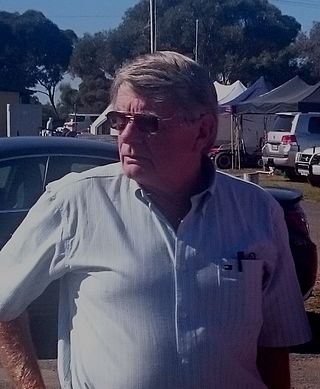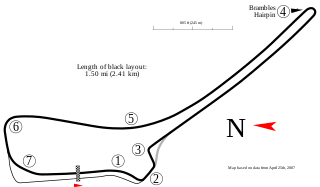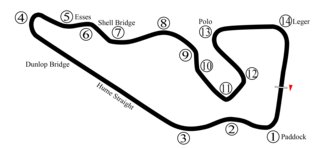
Colin John Bond is an Australian former racing driver. Bond reached the highest levels in Australian motorsport in 1969 when he was recruited by Harry Firth to the newly formed Holden Dealer Team. He quickly found success, winning the 1969 Hardie-Ferodo 500 mile race at Bathurst, New South Wales in a Holden Monaro.
Allan George MoffatOBE is a Canadian-born Australian racing driver known for his four championships in the Australian Touring Car Championship, six wins in the Sandown 500 and his four wins in the Bathurst 500/1000. Moffat was inducted into the V8 Supercars Hall of Fame in 1999.
Robert Frederick Jane was an Australian race car driver and prominent entrepreneur and business tycoon. A four-time winner of the Armstrong 500, the race that became the prestigious Bathurst 1000 and a four-time Australian Touring Car Champion, Jane was well known for his chain of tyre retailers, Bob Jane T-Marts. Jane was inducted into the V8 Supercars Hall of Fame in 2000.

Calder Park Raceway is a motor racing circuit in Melbourne, Victoria, Australia. The complex includes a dragstrip, a road circuit with several possible configurations, and the "Thunderdome", a high-speed banked oval equipped to race either clockwise or anti-clockwise.

The Tasmania SuperSprint is an annual motor racing event for Supercars, held at Symmons Plains Raceway in Launceston, Tasmania. The event has been a regular part of the Supercars Championship—and its previous incarnations, the Australian Touring Car Championship, Shell Championship Series and V8 Supercars Championship—since 1969.
The 1970 Australian Touring Car Championship was a CAMS-sanctioned motor racing title for drivers of Group C Improved Production Touring Cars and Group E Series Production Touring Cars. The title, which was the 11th Australian Touring Car Championship, began at Calder Park Raceway on 22 March 1970 and ended at Symmons Plains Raceway on 15 November after seven heats.
The 1971 Australian Touring Car Championship was a CAMS-sanctioned motor racing title for drivers of Group C Improved Production Touring Cars and Group E Series Production Touring Cars. The title, which was the 12th running of the Australian Touring Car Championship, began at Symmons Plains Raceway on 1 March 1971 and ended at Oran Park Raceway on 8 August after seven heats.
Ian Anthony "Pete" Geoghegan, was an Australian race car driver, known for a quick wit and natural driving skills. Sometimes referred to as "Pete" Geoghegan, he was one of the iconic characters of the 1960s and 1970s Australian motor racing scene. His older brother Leo was also an accomplished driver and the brothers often shared a car in endurance events.

The 1973 Hardie-Ferodo 1000 was the 14th running of the Bathurst 1000 touring car race. This was the first race to be held under the new metric

The Longford Circuit was a temporary motor racing course laid out on public roads at Longford, 23-kilometre (14 mi) south-west of Launceston in Tasmania, Australia. It was located on the northern edges of the town and its 7.242 km (4.500 mi) lap passed under a railway line viaduct, crossed the South Esk River via the wooden Kings Bridge, turned hard right at the doorstep of the Longford Hotel, passed over the railway line using a level crossing and traversed the South Esk again via another wooden structure, the Long Bridge.

The 1961 Australian Touring Car Championship was a CAMS sanctioned Australian motor racing title for drivers of Appendix J Touring Cars. The championship, which was contested over a single, 50 mile (82 km) race at the Lowood Airfield Circuit in Queensland on 3 September 1961, was the second Australian Touring Car Championship. The race, which was promoted by the Queensland Racing Drivers' Club, was won by Bill Pitt, driving a Jaguar Mark 1 3.4.

The 1964 Australian Touring Car Championship was a CAMS sanctioned national motor racing title for drivers of Appendix J Touring Cars and Group E Series Production Touring Cars. The championship, which was the fifth Australian Touring Car Championship, was contested over a single race staged at the Lakeside International Raceway in Queensland, Australia, on 26 July 1964. The race was won by Ian Geoghegan, the first of his five Australian Touring Car Championship titles. Geoghegan drove a Ford Cortina GT in what was the first Australian Touring Car Championship victory for a Ford driver and the first time that a Jaguar driver did not win the title.

The 1983 Australian Touring Car Championship was a CAMS sanctioned motor racing title for drivers of Group C Touring Cars. The title, which was the 24th Australian Touring Car Championship, was contested over a series which began on 6 February 1983 at Calder Park Raceway and ended on 19 June at Lakeside International Raceway after eight rounds.
The 1965 Australian Touring Car Championship was a CAMS sanctioned motor racing title open to Group C Improved Production Touring Cars. It was contested over a single 40-lap race staged at Sandown Raceway in Melbourne, Victoria, Australia on 11 April 1965. It was the sixth Australian Touring Car Championship title to be awarded and the first to be contested by cars complying with Group C regulations.

The 1966 Australian Touring Car Championship was a CAMS sanctioned Australian motor racing title open to Group C Improved Production Touring Cars. It was contested over a single 20-lap race staged at the Mount Panorama Circuit near Bathurst in New South Wales, Australia on Easter Monday, 11 April 1966, and was the seventh running of the Australian Touring Car Championship. The race was sponsored by the Neptune Oil Company, Sydney.

The 1962 Australian Touring Car Championship was a CAMS sanctioned Australian motor racing title for Appendix J Touring Cars. It was contested as a single race, staged at the Longford Circuit, in Tasmania, Australia, on 3 March 1962. The title, which was the third Australian Touring Car Championship, was won by Bob Jane, driving a Jaguar Mark 2 3.8.
The 1963 Australian Touring Car Championship was a CAMS sanctioned motor racing title for drivers of Appendix J Touring Cars. It was contested over a single 25 lap, 50 mile (80 km) race at the Mallala Race Circuit in South Australia on 15 April 1963 and was the fourth running of the Australian Touring Car Championship. The race was won by Bob Jane, driving a Jaguar Mark 2 4.1.

The 1967 Australian Touring Car Championship was a CAMS sanctioned national motor racing title open to Group C Improved Production Touring Cars. It was contested over a single race, staged at the Lakeside Circuit in Queensland, Australia on 30 July 1967. The title, which was the eighth Australian Touring Car Championship, was won by Ian Geoghegan, driving a Ford Mustang.

The 1968 Australian Touring Car Championship was a CAMS sanctioned Australian motor racing title open to Group C Improved Production Touring Cars. It was contested over a single race staged at the Warwick Farm circuit in New South Wales, Australia on 8 September 1968. The title, which was the ninth Australian Touring Car Championship, was won by Ian Geoghegan driving a Ford Mustang. It was the final Australian Touring Car Championship held as a single race, with the title being contested over a series of races from 1969 onwards.
The 1972 Australian Touring Car Championship was a CAMS sanctioned national motor racing title open to Group C Improved Production Touring Cars and Group E Series Production Touring Cars. The championship, which was the 13th running of the Australian Touring Car Championship, began at Symmons Plains and ended at Oran Park after eight rounds.









